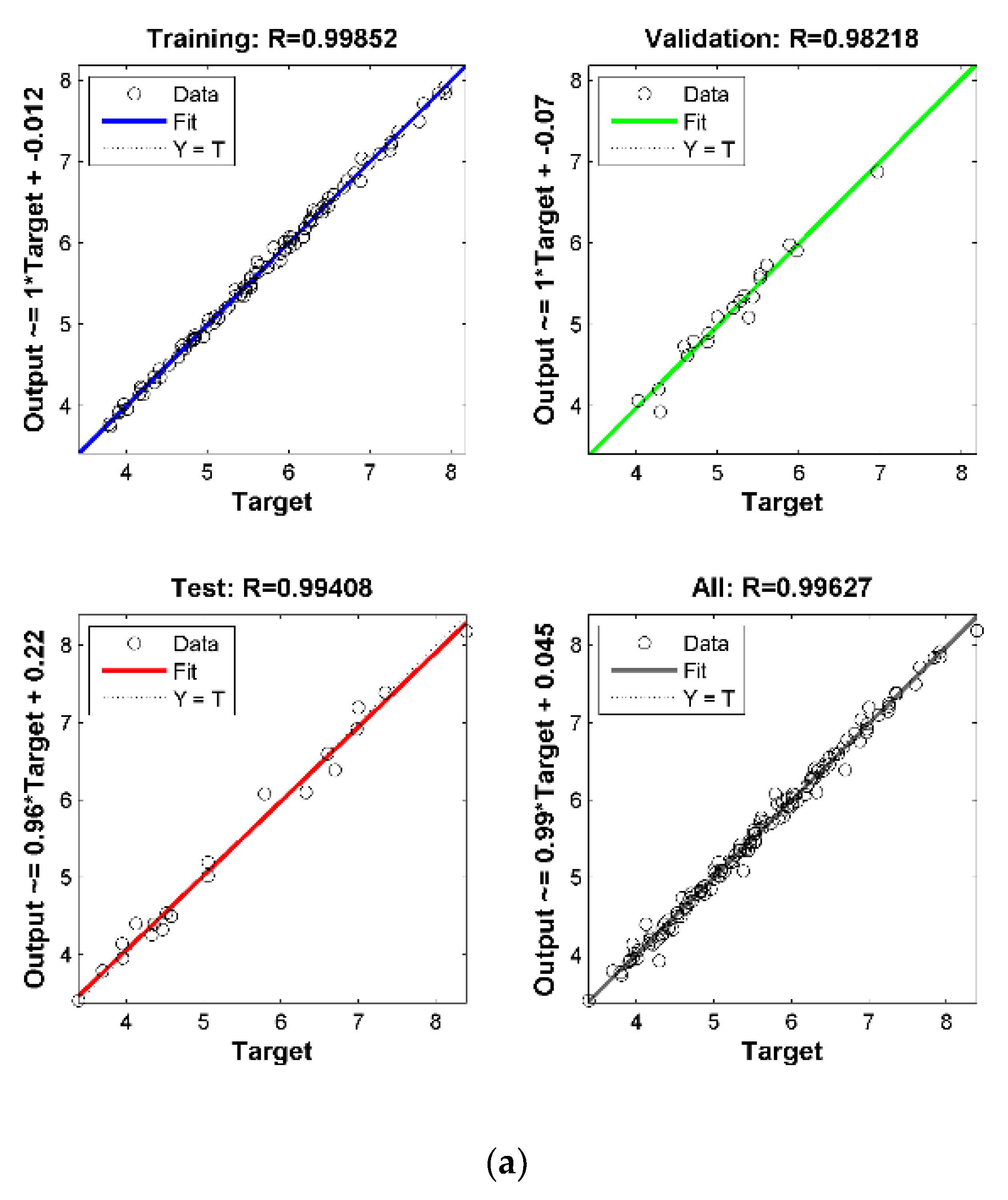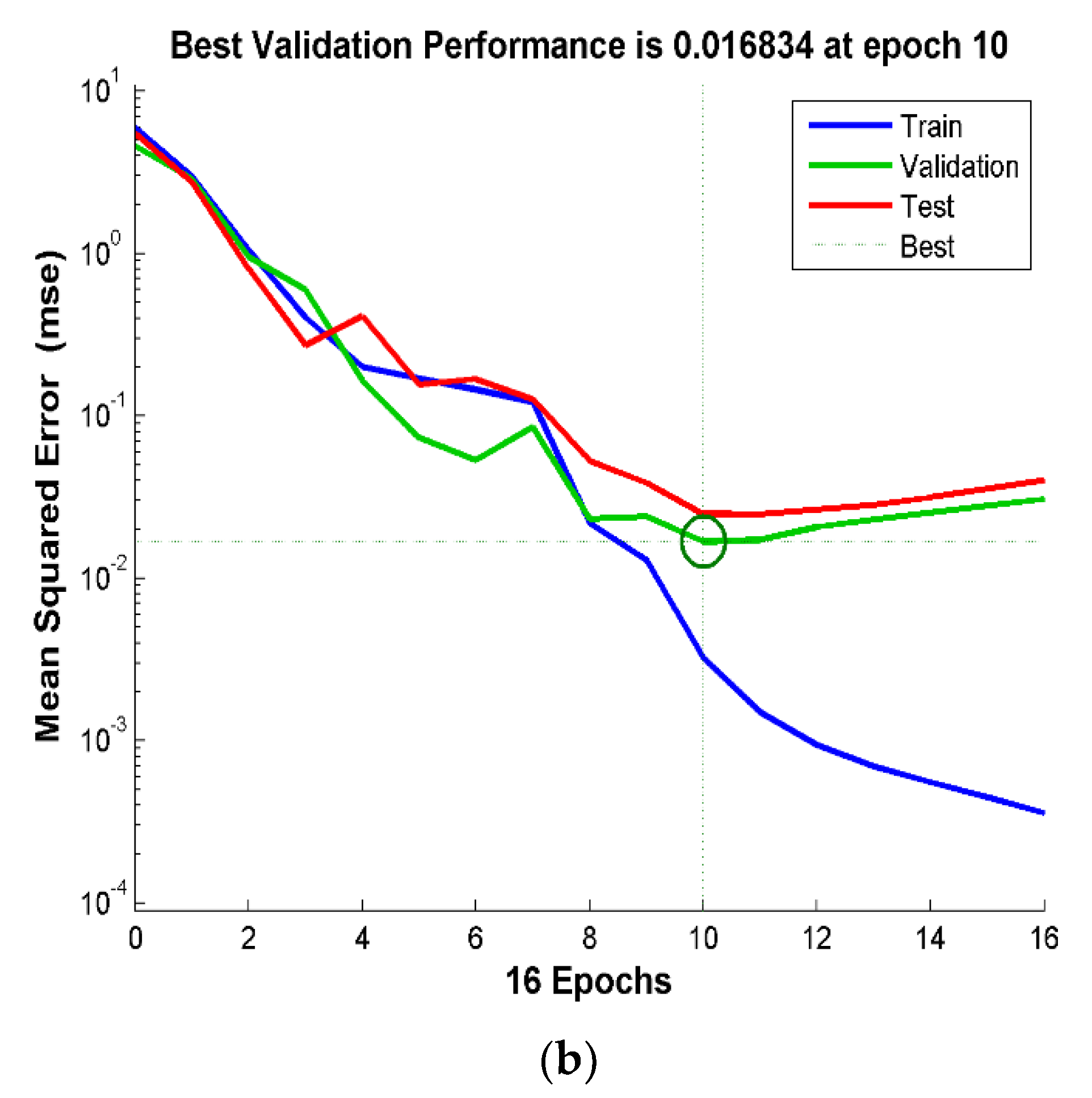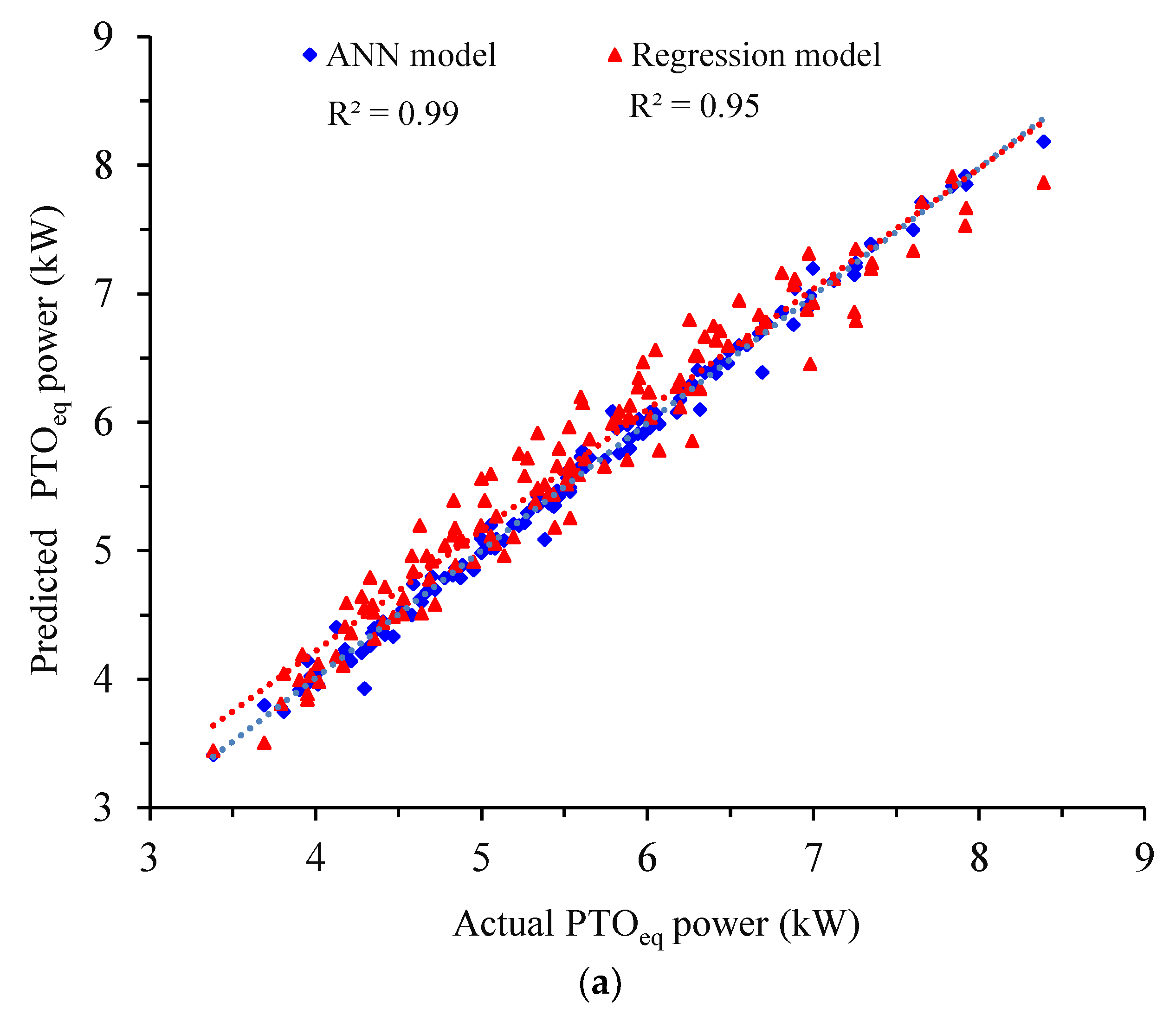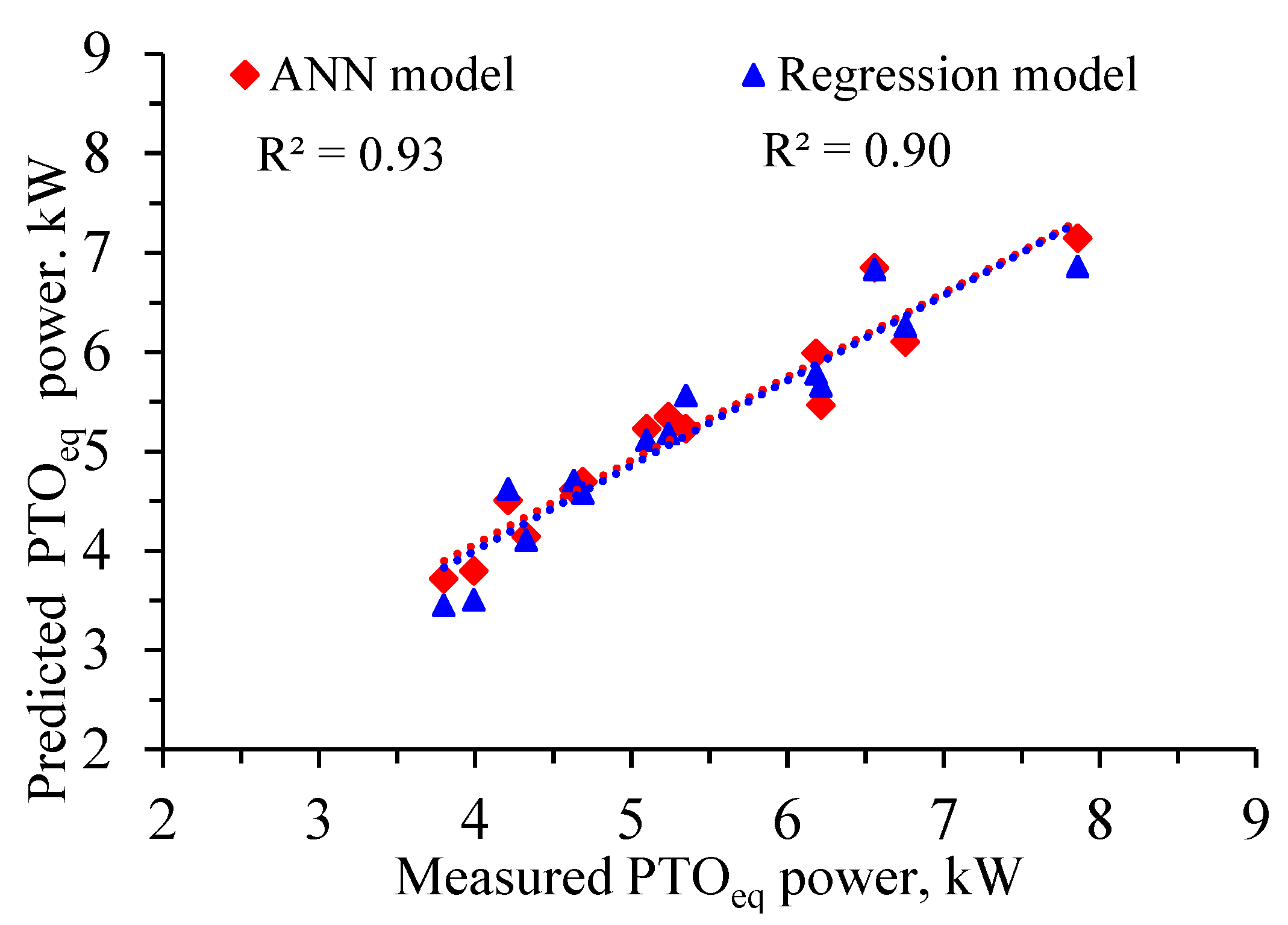Predicting the Power Requirement of Agricultural Machinery Using ANN and Regression Models and the Optimization of Parameters Using an ANN–PSO Technique
Abstract
1. Introduction
2. Materials and Methods
2.1. Prototype Active–Passive Disc Harrow and Its Associated Test Rig for Soil-Bin Investigations
2.2. Experimental Plan for Tests in the Soil Bin
2.3. Instrumentation and Measurements for Tests in the Soil Bin
2.4. Experimental Procedure for Tests in the Soil Bin
2.5. Estimation of Equivalent PTO (PTOeq) Power of the Tractor
2.6. Development of ANN and Regression Models
2.6.1. ANN Model
2.6.2. Regression Model
2.7. Optimization Using Particle Swarm Optimization (PSO)
3. Results and Discussion
3.1. Effect of Operational Parameters on Specific Draft of APDH
3.2. Effect of Operational Parameters on Specific Torque of APDH
3.3. Effect of Operational Parameters on PTOeq Power of APDH
3.4. Multiple Regression Model
3.5. Performance of ANN and Regression Models during the Training and Testing Phases
3.6. Validation of Formulated Models with Independent Data
3.7. Prediction of Optimal Parameters Using ANN–PSO
4. Conclusions
- Both the ANN and regression models performed well in predicting the power requirement; however, the ANN model had superior performance over the regression model, as evidenced by high R2 values and low MSE during the training, testing, and validation phases.
- The well-trained ANN model was then integrated with PSO and different combinations of optimal parameters were predicted by ANN–PSO with good accuracy and lesser variation (±6.85%) between the predicted and actual PTOeq power.
- The combination of a 36.6° front gang angle, 0.50 MPa cone index, 100 mm depth, and 3.90 u/v ratio was found to be an optimal setting for the predicted PTOeq power of 3.36 kW against 3.45 kW (actual).
- It was observed that all combinations of soil and working parameters (i.e., CI and depth) exhibited an optimal front gang angle in the range of 35 ± 2° and a u/v ratio of 3.65 ± 0.25 to achieve the minimum PTOeq power.
Author Contributions
Funding
Data Availability Statement
Acknowledgments
Conflicts of Interest
References
- Wilkes, R.D.; Addai, S.H. The use of the ‘Wye Double Digger’ as an alternative to the plough to reduce energy requirement per hectare and soil damage. In Proceedings of the International Conference on Agricultural Engineering, Richmond, Australia, 25–30 September 1988. Paper (No. 88-190). [Google Scholar]
- Shinners, K.J.; Wilkes, J.M.; England, T.D. Performance characteristics of a tillage machine with active-passive components. J. Agric. Eng. Res. 1993, 55, 277–297. [Google Scholar]
- Manian, R.; Kathirvel, K. Development and evaluation of an active-passive tillage machine. Agric. Mech. Asia Afr. Lat. Am. 2001, 32, 9–18. [Google Scholar]
- Mehta, C.R.; Singh, K.; Selvan, M.M. A decision support system for selection of tractor–implement system used on Indian farms. J. Terramech. 2011, 48, 65–73. [Google Scholar] [CrossRef]
- Upadhyay, G.; Raheman, H. Effect of velocity ratio on performance characteristics of an active-passive combination tillage implement. Biosyst. Eng. 2020, 191, 1–12. [Google Scholar]
- Sarkar, P.; Upadhyay, G.; Raheman, H. Active-passive and passive-passive configurations of combined tillage implements for improved tillage and tractive performance: A review. Span. J. Agric. Res. 2021, 19, e02R01. [Google Scholar] [CrossRef]
- Ranjbarian, S.; Askari, M.; Jannatkhah, J. Performance of tractor and tillage implements in clay soil. J. Saudi Soc. Agric. Sci. 2017, 16, 154–162. [Google Scholar]
- Nataraj, E.; Sarkar, P.; Raheman, H.; Upadhyay, G. Embedded digital display and warning system of velocity ratio and wheel slip for tractor operated active tillage implements. J. Terramech. 2021, 97, 35–43. [Google Scholar]
- Damanauskas, V.; Velykis, A.; Satkus, A. Efficiency of disc harrow adjustment for stubble tillage quality and fuel consumption. Soil Tillage Res. 2019, 194, 104311. [Google Scholar] [CrossRef]
- Fawzi, H.; Mostafa, S.A.; Ahmed, D.; Alduais, N.; Mohammed, M.A.; Elhoseny, M. TOQO: A new tillage operations quality optimization model based on parallel and dynamic decision support system. J. Clean. Prod. 2021, 316, 128263. [Google Scholar]
- Sablani, S.S.; Ramaswamy, H.S.; Sreekanth, S.; Prasher, S.O. Neural network modeling of heat transfer to liquid particle mixtures in cans subjected to end-over-end processing. Food Res. Int. 1997, 30, 105–116. [Google Scholar]
- Kumar, N.; Upadhyay, G.; Kumar, P. Comparative Performance of Multiple Linear Regression and Artificial Neural Network Based Models in Estimation of Evaporation. Adv. Res. 2017, 11, 1–11. [Google Scholar]
- Kalogirou, S.A. Artificial neural networks in renewable energy systems applications: A review. Renew. Sustain. Energy Rev. 2001, 5, 373–401. [Google Scholar]
- Kumar, M.; Yadav, N. Multilayer perceptrons and radial basis function neural network methods for the solution of differential equations: A survey. Comput. Math. Appl. 2011, 62, 3796–3811. [Google Scholar] [CrossRef]
- Zeng, Z.; Chen, Y.; Zhang, X. Modelling the interaction of a deep tillage tool with heterogeneous soil. Comput. Electron. Agric. 2017, 143, 130–138. [Google Scholar] [CrossRef]
- Askari, M.; Abbaspour-Gilandeh, Y.; Taghinezhad, E.; Hegazy, R.; Okasha, M. Prediction and optimizing the multiple responses of the overall energy efficiency (OEE) of a tractor-implement system using response surface methodology. J. Terramech. 2022, 103, 11–17. [Google Scholar] [CrossRef]
- Wang, S.; Zhao, B.; Yi, S.; Zhou, Z.; Zhao, X. GAPSO-Optimized fuzzy PID controller for electric-driven seeding. Sensors 2022, 22, 6678. [Google Scholar] [CrossRef]
- Alzoubi, I.; Delavar, M.R.; Mirzaei, F.; Nadjar Arrabi, B. Comparing ANFIS and integrating algorithm models (ICA-ANN, PSO-ANN, and GA-ANN) for prediction of energy consumption for irrigation land leveling. Geosystem Eng. 2018, 21, 81–94. [Google Scholar] [CrossRef]
- Rabbani, A.; Samui, P.; Kumari, S. A novel hybrid model of augmented grey wolf optimizer and artificial neural network for predicting shear strength of soil. Model. Earth Syst. Environ. 2023, 9, 2327–2347. [Google Scholar] [CrossRef]
- Hassan, R.; Cohanim, B.; De Weck, O.; Venter, G. A comparison of particle swarm optimization and the genetic algorithm. In Proceedings of the 46th AIAA/ASME/ASCE/AHS/ASC Structures, Structural Dynamics and Materials Conference, Austin, TX, USA, 18–21 April 2005; p. 1897. [Google Scholar]
- Kundu, P.; Paul, V.; Kumar, V.; Mishra, I.M. Formulation development, modeling and optimization of emulsification process using evolving RSM coupled hybrid ANN-GA framework. Chem. Eng. Res. Des. 2015, 104, 773–790. [Google Scholar] [CrossRef]
- Hoki, M.; Burkhardt, T.H.; Wilkinson, R.H.; Tanoue, T. Study of PTO driven powered disk tiller. Trans. ASAE 1988, 31, 1355–1360. [Google Scholar] [CrossRef]
- Salokhe, V.M.; Quang, N.B. Dynamics of a powered disk in clay soil. J. Terramech. 1995, 32, 231–244. [Google Scholar] [CrossRef]
- Hann, M.J.; Giessibl, J. Force measurements on driven discs. J. Agric. Eng. Res. 1998, 69, 149–157. [Google Scholar] [CrossRef]
- Nalavade, P.P.; Salokhe, V.M.; Niyamapa, T.; Soni, P. Performance of free rolling and powered tillage discs. Soil Tillage Res. 2010, 109, 87–93. [Google Scholar]
- ASAE S313.3; Soil Cone Penetrometer. ASABE Standards: St. Joseph, MI, USA, 2001.
- ASA 30-2.2-1965; Methods of Soil Analysis. Bulk Density. ASA Standards: Madison, WI, USA, 1965.
- ASAE D497.5; Agricultural Machinery Management Data. ASABE Standards: St. Joseph, MI, USA, 2006.
- Marquardt, D.W. An algorithm for least-squares estimation of nonlinear parameters. J. Soc. Ind. Appl. Math. 1963, 11, 431–441. [Google Scholar]
- Parrott, D.; Li, X. Locating and tracking multiple dynamic optima by a particle swarm model using speciation. IEEE Trans. Evol. Comput. 2006, 10, 440–458. [Google Scholar] [CrossRef]
- O’Dogherty, M.J.; Godwin, R.J.; Hann, M.J.; Al-Ghazal, A.A. A geometrical analysis of inclined and tilted spherical plough discs. J. Agric. Eng. Res. 1996, 63, 205–217. [Google Scholar]
- Islam, M.S.; Salokhe, V.M.; Gupta, C.P.; Hoki, M. Effects of PTO-powered disk tilling on some physical properties of Bangkok clay soil. Soil Tillage Res. 1994, 32, 93–104. [Google Scholar] [CrossRef]










| Particulars | Value |
|---|---|
| Type of disc harrow | Offset |
| Type of discs | Spherical with notched concave surfaces at the front and smooth discs at the rear |
| Diameter of discs, mm | 510 |
| Concavity of discs, mm | 60 |
| Spacing between discs, mm | 225 |
| Gang axle, mm × mm | 25 × 25 |
| Working width, mm | 630 |
| Gang angle adjustment, degrees | 25 to 40 |
| Overall dimensions (l × w × h), mm × mm × mm | 1965 × 1620 × 1237 |
| Variables | Levels | Values |
|---|---|---|
| General factors | ||
| Soil texture | 1 | Sandy clay loam |
| Soil moisture content (MC), % (db) | 1 | 10 ± 1 |
| Working width, mm | 1 | 630 |
| Forward speed, km h−1 | 1 | 3.2 |
| Rear gang angle (β), degrees | 1 | 30 |
| Independent factors | ||
| Front gang angle (α), degrees | 4 | 25, 30, 35, and 40 |
| Operating depth, mm | 3 | 100, 120, and 140 |
| u/v ratio | 4 | 2.40, 3.00, 3.60, and 4.60 |
| Soil CI, MPa (bulk density, g cm−3) | 3 | 0.50 ± 0.03 (1.43), 0.08 ± 0.03 (1.58), and 1.10 ± 0.03 (1.73) |
| Dependent factors | ||
| Draft, kN | ||
| Torque, kN-m |
| Variable | Levels | Specific Draft, kN m−2 | Specific Torque, kN m m−2 | Equivalent PTO Power Pe, kW |
|---|---|---|---|---|
| Front gang angle (α), degrees | 25 | 13.23 a | 5.15 a | 5.73 a |
| 30 | 14.71 b | 4.50 b | 5.50 b | |
| 35 | 17.04 c | 3.69 c | 5.19 c | |
| 40 | 23.12 d | 3.34 d | 5.63 a | |
| u/v ratio | 2.40 | 20.57 a | 5.38 a | 5.67 a |
| 3.00 | 18.32 b | 4.19 b | 5.34 b | |
| 3.60 | 14.99 c | 3.57 c | 5.08 c | |
| 4.60 | 14.22 d | 3.54 c | 5.95 d | |
| CI, MPa | 0.50 | 13.47 a | 3.06 a | 4.40 a |
| 0.80 | 17.08 b | 4.29 b | 5.58 b | |
| 1.10 | 20.52 c | 5.16 c | 6.55 c | |
| Operating depth, mm | 100 | 18.00 a | 4.48 a | 4.90 a |
| 120 | 16.85 b | 4.14 b | 5.50 b | |
| 140 | 16.23 c | 3.89 c | 6.13 c |
| Dependent Variable: PTOeq Power, kW | |||
|---|---|---|---|
| Source | df | Mean Square | Computed F Value |
| Model | 144 | 94.75 | 751.95 ** |
| α | 3 | 5.99 | 47.56 ** |
| CI | 2 | 167.44 | 1328.83 ** |
| depth | 2 | 54.89 | 435.61 ** |
| u/v ratio | 3 | 15.55 | 123.40 ** |
| α × CI | 6 | 0.10 | 0.82 |
| α × depth | 6 | 0.29 | 2.33 ** |
| α × u/v ratio | 9 | 0.21 | 1.68 |
| CI × depth | 4 | 1.44 | 11.47 ** |
| CI × u/v ratio | 6 | 0.33 | 2.65 |
| depth × u/v ratio | 6 | 0.04 | 0.35 |
| α × CI × depth | 12 | 0.04 | 0.33 |
| α × CI × u/v ratio | 18 | 0.04 | 0.29 |
| α × depth × u/v ratio | 18 | 0.01 | 0.09 |
| CI × depth × u/v ratio | 12 | 0.02 | 0.13 |
| α × CI × depth × u/v ratio | 36 | 0.01 | 0.08 |
| Error | 288 | 0.13 | |
| Regression Coefficients | PTOeq Power Model | |
|---|---|---|
| Estimate | Standard Error | |
| C0 | 12.30 | 0.903 |
| C1 | −0.452 | 0.049 |
| C2 | 0.007 | 0.001 |
| C3 | −3.76 | 0.247 |
| C4 | 0.55 | 0.035 |
| C5 | 3.59 | 0.077 |
| C6 | 0.03 | 0.001 |
| Source | PTOeq Power Model (R2 = 0.95) | ||
|---|---|---|---|
| SS | df | MS | |
| Regression | 4541.18 | 7 | 648.74 |
| Residual | 7.10 | 137 | 0.05 |
| UT | 4548.28 | 144 | - |
| CT | 174.44 | 143 | - |
| Model | RMSE | MAPE | R2 | |||
|---|---|---|---|---|---|---|
| Training | Testing | Training | Testing | Training | Testing | |
| ANN | 0.093 | 0.176 | 1.214 | 2.871 | 0.99 | 0.98 |
| Regression | 0.271 | 0.229 | 4.001 | 3.644 | 0.95 | 0.96 |
| S. No. | RMSE | MAPE | R2 | α, ° | CI, MPa | Depth, mm | u/v Ratio | PTOeq Power | Variation, % | ||||
|---|---|---|---|---|---|---|---|---|---|---|---|---|---|
| Training | Testing | Training | Testing | Training | Testing | Predicted | Actual | ||||||
| 1 | 0.154 | 0.302 | 1.509 | 4.018 | 0.98 | 0.95 | 35.0 | 0.5 | 100 | 3.60 | 3.36 | 3.59 | −6.85 |
| 2 | 0.165 | 0.266 | 2.058 | 4.903 | 0.98 | 0.90 | 35.5 | 0.5 | 120 | 3.40 | 4.00 | 3.89 | 2.75 |
| 3 | 0.093 | 0.176 | 1.214 | 2.871 | 0.99 | 0.98 | 36.6 | 0.5 | 100 | 3.90 | 3.36 | 3.45 | −2.67 |
| 4 | 0.125 | 0.111 | 1.521 | 1.773 | 0.99 | 0.99 | 35.7 | 0.5 | 140 | 3.90 | 4.20 | 4.02 | 4.29 |
Disclaimer/Publisher’s Note: The statements, opinions and data contained in all publications are solely those of the individual author(s) and contributor(s) and not of MDPI and/or the editor(s). MDPI and/or the editor(s) disclaim responsibility for any injury to people or property resulting from any ideas, methods, instructions or products referred to in the content. |
© 2024 by the authors. Licensee MDPI, Basel, Switzerland. This article is an open access article distributed under the terms and conditions of the Creative Commons Attribution (CC BY) license (https://creativecommons.org/licenses/by/4.0/).
Share and Cite
Upadhyay, G.; Kumar, N.; Raheman, H.; Dubey, R. Predicting the Power Requirement of Agricultural Machinery Using ANN and Regression Models and the Optimization of Parameters Using an ANN–PSO Technique. AgriEngineering 2024, 6, 185-204. https://doi.org/10.3390/agriengineering6010012
Upadhyay G, Kumar N, Raheman H, Dubey R. Predicting the Power Requirement of Agricultural Machinery Using ANN and Regression Models and the Optimization of Parameters Using an ANN–PSO Technique. AgriEngineering. 2024; 6(1):185-204. https://doi.org/10.3390/agriengineering6010012
Chicago/Turabian StyleUpadhyay, Ganesh, Neeraj Kumar, Hifjur Raheman, and Rashmi Dubey. 2024. "Predicting the Power Requirement of Agricultural Machinery Using ANN and Regression Models and the Optimization of Parameters Using an ANN–PSO Technique" AgriEngineering 6, no. 1: 185-204. https://doi.org/10.3390/agriengineering6010012
APA StyleUpadhyay, G., Kumar, N., Raheman, H., & Dubey, R. (2024). Predicting the Power Requirement of Agricultural Machinery Using ANN and Regression Models and the Optimization of Parameters Using an ANN–PSO Technique. AgriEngineering, 6(1), 185-204. https://doi.org/10.3390/agriengineering6010012







